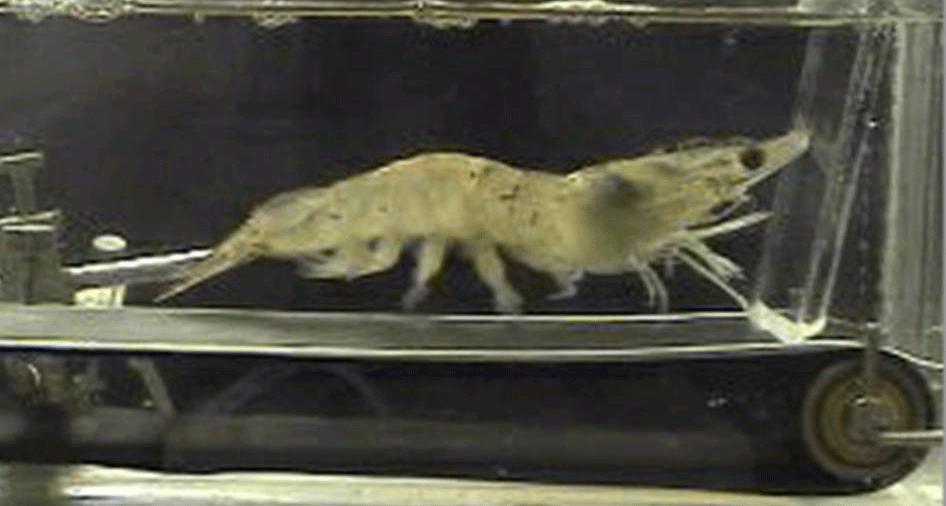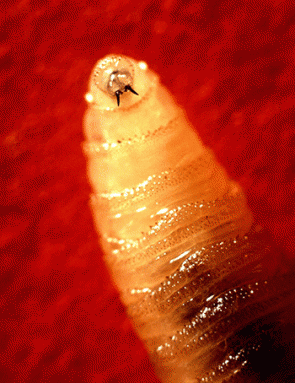Shrimp on treadmills? Some science only sounds silly
Experiments that may seem odd almost always have a valuable purpose

Critics made fun of spending for "shrimp on a treadmill" research, but it was a small part of an important study into a disease afflicting this 'farmed' species.
D. Scholnick
By Sid Perkins
BOSTON, Mass. — What could be sillier than a big shrimp running on a treadmill? When comedians heard about a scientist who made shrimp do his, plenty of them made jokes. A number of politicians did too. Some even complained about all the money those scientists were wasting. A few critics had argued that the researchers had spent up to $3 million. But the real joke is on those critics.
The treadmill, much of it cobbled together from spare parts, cost less than $50. And there was a serious scientific purpose in making those shrimp run. Researchers described this and a few other supposedly ridiculous projects here, on February 18, at the annual meeting of the American Association for the Advancement of Science. All of these projects had important goals. They also gleaned valuable data.
Litopineas vannamei is commonly known as the Pacific white shrimp. These tasty crustaceans grow up to 230 millimeters (9 inches) long. They swim along the Pacific coasts of Mexico, Central America and parts of South America. For many years, most of these shrimp in grocery stores and markets had been caught by fishermen. Now, most are raised in captivity. They come from the aquatic equivalent of farms.
Worldwide, people have eaten more than 2 million tons of these farmed shrimp each year for the past decade.
(Story continues after video)
David Scholnick is a marine biologist at Pacific University in Forest Grove, Ore. There, he studies these shrimp, among other creatures. About 10 years ago, he was studying some shrimp farms plagued by large amounts of bacteria. He suspected the germs were making it tough for the shrimp to get oxygen from the water. Like a person with a heavy cold, it would be difficult for them to breathe. Scholnick also suspected sick shrimp would get tired more quickly than healthy ones. Indeed, the shrimp he was observing had normally been quite active. Now, they often remained motionless in their tanks.
The only way to test whether the animals were truly tiring too quickly was to give them a workout. He or someone on his team could prod the shrimp and chase them around the tank. But Scholnick thought there must be a better way. And his solution: a treadmill.
A budget-conscious MacGyver
Of course, companies don’t make treadmills for shrimp. So Scholnick built his own. Because his team’s budget was tight, he used spare parts that had been laying around. For the moving belt on the treadmill, he cut a rectangular piece of rubber from a large inner tube. He looped that conveyor belt around a couple of wheel assemblies taken from a skateboard. Those were mounted onto a scrap of wood. He used a small motor taken from another piece of equipment to power the treadmill. The only money he spent was $47 for the plastic panels used to build the tank that would hold the treadmill.
“Yes, the video of the shrimp on the treadmill looks odd,” Scholnick admits. “It’s easy to make fun of.”
But that part of the research was only a small part of a much larger project, he adds. And the summer that he and his team built their treadmill, they had a research budget of about $35,000. Most of that money went to paying paying team members (who, over the course of the summer, ended up making only about $4 per hour, Scholnick recalls).

But critics who thought Scholnick’s work was “silly” made it sound like the researchers wasted huge sums of money just for the fun of it. They even exaggerated the amounts by adding up all of the money that Scholnick had received for all of his other research studies. Some critics even included money received by other researchers who had worked with Scholnick on unrelated projects. The largest total some had reported was around $3 million — which could certainly get people mad if they didn’t understand the real story.
In fact, the work had an important goal. It sought to probe why this species’ immune system hasn’t been fighting off infection as it should. If he and other researchers can figure that out, they just might be able to develop a treatment. That, in turn, could let farmers raise larger numbers of healthy shrimp.
From ducks to killer flies
Many people criticize government spending on projects that appear silly, says Patricia Brennan. She knows about this from personal experience. An evolutionary biologist at the University of Massachusetts in Amherst, plenty of people have made fun of her work. Among other things, she’s studied the dramatic changes over the course of the year in the size and shape of sex organs in male ducks. They enlarge greatly during mating season. Later, they shrink again. In particular, she’s investigated whether those changes were driven by hormones. She also probed whether the change in size of those organs is affected by having to compete for mates with other males.
Such studies are important to understanding the basic biology of an important species.

Yet critics seem to be especially fond of poking fun at biological studies, Brennan claims. She cited several other examples of such allegedly “silly” science. One was using robotic squirrels to study the behavior of rattlesnakes. The sight of a robotic squirrel is easy to make fun of. But that was just a small part of an investigation into how the heat-sensing pits on a rattlesnake’s snout are used to track its warm-blooded prey.
“People often wonder why scientists study the sex lives of odd animals,” says Brennan. That’s a good question, she notes. But, she adds, there also are usually very good answers. Take, for example, the screwworm fly. They are a big pest in the developing world. Some 65 years ago, they also were a big pest in the United States. Back then, they cost ranchers and dairy farmers about $200 million each year, according to government statistics. (That would equal about $1.8 billion today.)
These flies lay their eggs in tiny wounds on cattle. Soon afterward, fly larvae hatch and begin eating. If the cattle aren’t treated, the insects can cause infections that bring down an adult cow in fewer than two weeks. A calf can die even more quickly.
Researchers who studied screwworm flies found out that a female mates only once in her life. So, they came up with a neat idea: If the only males available to young female flies were sterile — unable to fertilize eggs — then there would never be a new generation of flies. Populations would drop and the pests could be eradicated.
The original research projects only cost about $250,000 and were spread over several decades. But that research has saved U.S. ranchers and dairy farmers, alone, billions of dollars over the past 50 years, notes Brennan. Those flies are no longer a U.S. plague.
“Ahead of time, it’s tough to predict which projects will be successful,” Brennan points out. Indeed, potential applications of research often are unknown. But every successful project derives from the results of simple projects, such as the details of how an animal reproduces. So even research that may seem silly, she argues, can sometimes pay off big.







